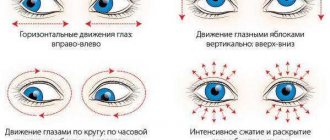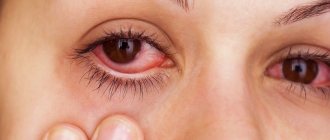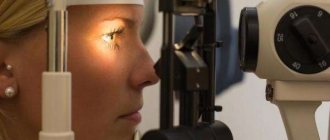Reasons for flashing flies
About the destruction of the vitreous body
The cavity between the retina of the eye and its lens is filled with a gel-like substance - the vitreous humor. It contains 99% water and 1% various substances (hyaluronic acid, collagen, etc.). In its normal state, the vitreous body is completely transparent due to the strict composition and structure of the molecules of the incoming substances.
Under the influence of various factors, molecules break up into fragments, which qualitatively changes the composition and volume of the vitreous body. In its structure, particles are formed that do not have optical transparency.
This phenomenon is known in medicine as destruction of the vitreous body. These particles are perceived by vision as flying flies.
If blood, medicine or another substance (which should not be in it) gets into the vitreous body, then a visual effect appears, as if it were destroyed.
Destruction can develop due to the natural physiological aging of the body. From the age of 40, many people notice the occurrence of flying floaters to varying degrees. But the age limit is relative. Floaters can also be observed at a young age.
Vitreous compartment
Floater pathology can occur when the vitreous humor moves away from the back wall of the eye. After such a movement, periodic flashes and flickering occur with an increase in the number of floating flies. These images appear due to the vitreous body flowing around the optic nerve around the ring.
Find out more about the disease of the sclera of the eye - episcleritis: description and treatment methods.
Did you know that anisometropia can cause strabismus or even blindness? Read more about what anisometropia is here.
With age, the vitreous body contracts, and this connection becomes weaker. The body moves freely in the inner space of the eye. It happens that it goes beyond the edges of the field of view.
Reasons for the appearance of floaters before the eyes
The causes of floaters before the eyes may be hidden in the pathology of blood vessels, the central nervous system, brain tissue, and the cervical spine. An experienced physician should identify potential causes. He examines the patient, collects medical history data and eliminates all possible negative factors.
The main reasons why floaters may periodically appear before the eyes:
- insufficiency of blood supply to cerebral structures;
- oxygen deficiency due to respiratory pathology;
- change in the position of blood vessels in the cervical spine;
- low hemoglobin level;
- low blood pressure;
- brain tumors;
- carbon monoxide poisoning;
- taking certain medications without medical supervision;
- high blood sugar.
The true cause of black spots before the eyes may be hidden in the deformation of the cervical spine. The vertebral bodies have foraminal openings through which the radicular nerves exit. These structures are responsible for the innervation of tissues and organs. They are protected by surrounding tissues and intervertebral discs. With dystrophic degenerative disease, the intervertebral discs undergo thinning and dehydration. They lose their shock-absorbing ability. Their height decreases and their area increases. This provokes the following pathological changes:
- compression of the radicular nerves leads to disruption of their blood supply, they lose the ability to fully perform their function;
- as compensation, the body launches an inflammatory response;
- the muscles of the neck and collar area are overstrained in order to compensate for the shock-absorbing capacity of damaged intervertebral discs;
- against the background of inflammation, blood microcirculation in the capillary bed increases, and soft tissue swelling develops.
All this causes spasm and compression of the posterior vertebral arteries. Further destruction of the intervertebral disc leads to instability of the position of the vertebral bodies. Subluxation of the first cervical vertebra and retrolisthesis of the second, third and fourth vertebrae occur periodically. Incorrect position of the vertebral bodies deforms the posterior vertebral arteries. The brain does not receive full nutrition. Characteristic symptoms appear: headache in the back of the head, dizziness, tinnitus, flickering spots in the eyes, drowsiness, decreased mental performance, etc.
Spondylosis and spondyloarthrosis are two diseases that potentially lead to damage not only to the posterior, but also to the lateral cerebral blood vessels. Vertebro-basilar insufficiency leads to the fact that the blood supply is disrupted and the optic nerve is affected. Sometimes the disease can be recognized during a scheduled consultation with a neurologist after the patient contacts an ophthalmologist with complaints of a sharp decrease in visual acuity.
Also, one should not exclude cerebral atherosclerosis, arterial hypertension, thyroid dysfunction, hyperglycemia, acute renal failure, intoxication, poisoning and a number of other conditions that may be accompanied by the appearance of spots before the eyes.
If black spots appear before your eyes and you feel dizzy, you should immediately seek medical help. This results in sudden blood loss. It may be hidden. For example, with a long-term course of diseases of the gastrointestinal tract, bleeding may develop. Only a stool test for occult blood will help identify it. Anemia of unspecified origin and the flickering of spots before the eyes is always a reason for a thorough examination of all organs and systems until the cause of the pathology is found.
Floaters as a symptom of other diseases
A certain category of people runs the risk of “getting” floaters floating in front of their eyes, regardless of age.
They can occur when:
- mechanical eye injuries,
- myopia,
- inflammatory processes in the eyes,
- metabolic disorders (especially diabetes mellitus),
- internal bleeding,
- changes in blood pressure,
- anemia (due to decreased levels of red blood cells and hemoglobin),
- cervical osteochondrosis (blood flow in the spinal arteries supplying the brain is disrupted),
- some poisonings,
- traumatic brain injury.
Question: What home remedies can be used to treat eye floaters?
Answer: Use cold and hot baths for the eyes. Apply a hot wet wipe to both eyes for 2 minutes, followed by an ice pack for 2 minutes. Repeat 3 or 4 times a day.
Take 120 g of fresh spinach, boil it in 4 glasses of water for 20 minutes. Drink this broth and eat spinach daily to provide vital nutrition to your eyes.
Question: What vitamin supplements for eyes can you recommend?
Answer: Take omega-3 fatty acids (3 to 9 g per day in capsule or liquid form). This supplement helps promote healthy blood circulation and reduce inflammation in the body.
A daily dose of vitamins A (200 IU), C (1000 mg) and E (800 IU), beta-carotene (1000 mg) and selenium (100 mcg) can help stop the progression of macular degeneration.
Daily use of lutein (30 mg), another form of beta-carotene, has been shown to help the macula.
Chlorophyll-rich algae such as spirulina, chlorella and blue-green algae (1 to 2 g per day) have nutrients that are beneficial for the eyes.
Therapeutic measures
Since floaters swimming in front of the eyes often serves as a symptom of a number of diseases, first of all a reliable diagnosis is necessary, followed by treatment of the identified disease.
Very rarely, floaters go away on their own. In most cases, opacities within the vitreous move out of the visible zone, but do not physically disappear. The doctor may not detect vision-threatening problems. Then no treatment is required, only psychological adaptation is needed. But often, in addition to psychological discomfort, people simply lose their vision.
What exactly are “flies”?
Myodesopsia is the medical name for a phenomenon in which a person, when looking to the side or upward, notices “running away” dots and spots. To understand the nature of the so-called goosebumps, rainbow circles and spots before the eyes, you need to understand how the human visual organs are anatomically structured. The eyes are a complex structure that includes many elements. The main ones are the following:
- cornea,
- lens,
- retina,
- sclera,
- vitreous body.
The vitreous body is a transparent, jelly-like substance that fills 80% of the eyeball. It is located between the lens and the retina. It is thanks to the vitreous body that the eye retains its round shape; in addition, it does not allow the retina to move and maintains normal intraocular pressure. So, 98% of the jelly-like substance is water. The remaining two percent are:
- glucose;
- ascorbic acid;
- inorganic salts;
- hyaluronic acid;
- collagen.
It is on the vitreous body that those floating cobwebs, dots and midges appear that bother many patients. Upon reaching a certain age, this phenomenon worries almost everyone. But there are cases when black or white dots in the eyes also appear in young people. The reasons for the appearance of spots before the eyes in this case are injuries to the head or organs of vision, heavy physical activity, unstable blood or intracranial pressure, and taking anticoagulant drugs. In women, multi-colored spots and spots often appear during pregnancy.
Opacities in the vitreous body, particles of calcium, fat or cholesterol cast a shadow on the retina and are perceived by the patient as those same “floaters” and “cobwebs”
The spots can be of various shapes and sizes, sometimes they seem voluminous, they can be almost colorless, dark or colored, sometimes the spots sparkle like lightning or stars. When moving the eyes, when a person tries to look at them, the spots and floaters also move. They are more clearly visible when looking at a white wall, a blank sheet of paper, or a clear sky on a sunny day.
Floaters can be age-related, harmless, they cause some discomfort, but do not affect vision - in this case, treatment is not required. And there are “floaters” that appear after an injury or with blood pressure disorders. In this case, you should definitely consult a doctor, get examined and choose the optimal treatment regimen.
Are there treatments for this pathology?
Drug therapy
To date, there is no information on medications that have proven effective in eliminating existing floaters or preventing new ones.
Some manufacturers of dietary supplements and medications are speculating on this problem, declaring their effectiveness in solving this problem.
Meanwhile, certain medications activate metabolic processes, which leads to the resorption of flies. These include, for example:
- eye drops "Emoxipin 1%",
- "Wobenzym", an enzyme preparation for internal use.
The resorption therapy regimen involves:
- Instill 1 drop of drops into the affected eye three times a day for a month;
- Take Wobenzym three times a day, 5 tablets each. Course 2-4 weeks.
This therapy is supplemented with vitamin and mineral complexes for vision containing lutein.
If the retina is damaged
When retinal damage is identified as the cause of floaters, this is eliminated with a laser beam or tissue freezing. The operation is performed under local anesthesia on an outpatient basis. By eliminating the tears, retinal detachment is prevented.
Fighting floaters surgically
There are some surgical methods for eliminating the destruction of the vitreous body:
- The vitreolysis procedure is performed with a VAG neodymium laser. The process involves targeting opaque areas and crushing them into small particles that do not interfere with vision. This method has not found widespread use due to serious side effects and little knowledge of the results.
- Vitrectomy, or removal of the vitreous body, all or part, along with which the floaters are also removed. A balanced salt solution is placed in place of the vitreous. This procedure is a risky surgery. It can cause serious consequences :
- cataract,
- bleeding in the eye,
- retinal detachment.
Is the disease - chalazion of the upper eyelid - dangerous? Find out what consequences this disease has for the eye.
Do your eyes get tired and there is acute discomfort in the form of pain? Here are the reasons for the pain in the eyes.
Do you know what the normal eye pressure is?
Meanwhile, the effectiveness of vitrectomy is very high, and many patients are satisfied with the result. But, since the procedure is unsafe, it is performed in exceptional cases.
Thus, ophthalmology has not yet “grown” to the level of an effective and at the same time safe solution to the problem with floaters. It occurs in many people. But today no unified treatment tactics or measures to prevent this phenomenon have been developed.
Question: Do I need to follow a diet if floaters appear in my eyes?
Herbalist's answer: Diet is very important for the health of our eyes!
Proper nutrition is important to ensure the eyes are nourished and to prevent toxic waste from building up in the body.
I recommend a nutritious, balanced diet rich in complex carbohydrates, organic sources of animal protein and whole grains.
To help nourish the eyes through the kidneys, liver and vital essence, eat more blood-building foods, including fresh vegetables such as spinach and beets, and dried fruits such as raisins, figs and prunes.
Include more of these foods in your diet: leeks, tomatoes, lettuce, Swiss chard, cilantro, carrots, cabbage, green peas, watercress, whole grains, beans (especially soybeans and mung beans), cloves, sesame seeds.
Fresh fruits, including apples, peaches, pears, blueberries and blackberries.
Avoid foods high in fat, animal fats, red meat, dairy and spicy foods, which contribute to the accumulation of toxins and waste in the body and need to be eliminated.
Avoid coffee and alcohol, which damage the yin essence.
What to do
Since a reliable remedy for flies has not yet been invented, you can try to deal with them yourself.
First step
The quality of the vitreous body is often interrelated with the general condition of the body. Therefore, you can start with the simplest and most obvious: switching to a healthy lifestyle. If the pathology has not gone far, then this recommendation is quite enough to solve the problem.
The transition to a healthy life is carried out according to standard rules accessible to any person:
- proper nutrition,
- physical exercise,
- giving up bad habits (smoking and alcohol).
When is it necessary to visit a doctor?
In certain situations, you cannot postpone visiting a doctor:
- when a whole swarm of flies appears before your eyes with blurred perception or darkening of any part of the visual field;
- if floaters appeared after a head or eye injury.
Simple Do-It-Yourself Techniques
When flies appear, you can resort to simple methods of getting rid of them:
- Sit on a chair, straighten your back, head straight, look forward. With a sharp movement, look to the left and immediately to the right. Move your eyes from top to bottom just as quickly. This gymnastics redistributes the fluid in the eyeball, after which the floaters are removed beyond the edges of the field of view.
- If something gets into your eyes, do not rub them. You just need to rinse them with clean water.
Before treating eye floaters
Any spots before the eyes are a sign of vascular and oxygen deficiency of the brain structures. Before treating black floaters before the eyes, you need to conduct a differential diagnosis and make a diagnosis. The disease, the symptom of which is floaters before the eyes, has its own cause of development. And addressing this cause is an effective treatment that can quickly and safely eliminate floaters before the eyes.
The first thing to do if floaters appear before your eyes is to consult a doctor for a diagnosis. An experienced neurologist will conduct an examination and a series of functional tests, make a preliminary diagnosis and tell you how to carry out further examination and treatment.
For functional diagnostics the following methods are used:
- X-ray of the cervical spine;
- angiography of neck vessels;
- MRI of brain structures;
- electroencephalogram.
In complex diagnostic cases, cerebrospinal fluid is collected using a spinal puncture. The study of cerebrospinal fluid allows us to exclude the possibility of a violation of its chemical composition, infection, etc.











